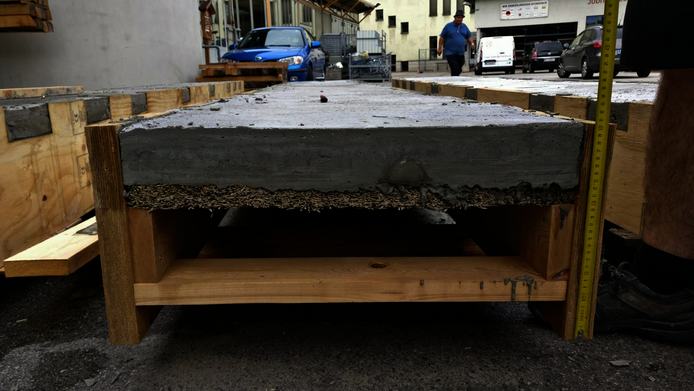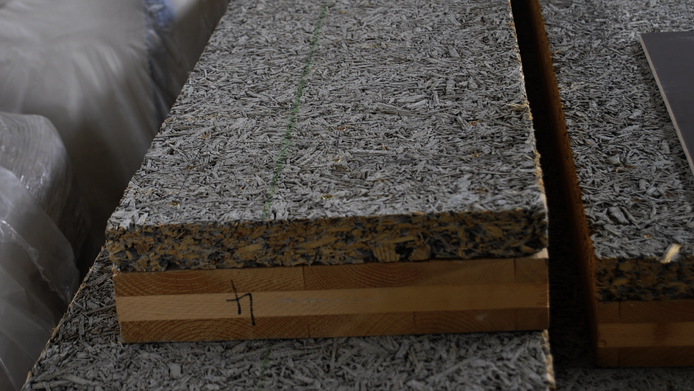Timber is gaining ground

Anyone building or renovating a home knows that when you mix conventional concrete in the right ratio you get a load-bearing material. In terms of sustainability, however, this "construction classic" is far from ideal. One alternative would be lightweight wood-concrete, in which gravel is replaced by various wood aggregates such as wood chips or sawdust. In order for this composite material to become established as a building material, however, important questions have yet to be answered, including load-bearing capacity. Great progress in tackling such questions has now been made by a research project funded by the Austrian Science Fund FWF. The focus was on the development of load-bearing components made of timber and cement-bonded-wood, whereby the researchers addressed both load-bearing capacity and environmental and economic aspects. They aimed at creating a resource-friendly building material based mainly on wood as a renewable resource. In addition, such material should also be easy to use and recycle. “We are researching a new generation of wood-concrete. Everyone should be able to buy it in DIY stores and mix it themselves, just like normal concrete today. Our goal is not a high-tech product, but a low-tech product that meets environmental and economic requirements”, says the principal investigator Alireza Fadai, Professor of Resource Efficient Structural Design at the Institute of Architecture and Design at the Vienna University of Technology (TU Wien).
Advanced mixing
The researchers involved, based in Vienna, as well as in Switzerland at the University of Applied Sciences Freiburg and the ETH Zurich, are gradually getting closer to translating this vision into reality. One of the central challenges for Fadai and his team was to arrive at the optimum mix of cement and wood particles from a large number of variants. The quality of the bond between the two components depends on a number of variables, such as type of wood, length and weight of the wood particles, quantity of water or type of cement. Right from the start, development focused on cost-effectiveness and new types of cement whose production releases less CO2. However, the compatibility of cement and wood particles is not the only aspect that determines the right mix. As a central component of such lightweight composite structural systems, cement-bonded wood must also meet all requirements with regard to load-bearing capacity, fire and noise protection as well as thermal insulation. Its lower weight is another big plus.
Design tool focusing on practical use
Although wood is often used in construction projects today, even in multi-storey buildings, wood-concrete tends to be used for non-structural elements, since its structural strength is difficult to predict. After all, it is important to know what a ceiling will look like in five years. For this reason, a suitable measurement method is crucial for market success, which is why developing such a method played a central role in the research project. Fadai relied on practice-proven methods and adapted them for composite systems consisting of timber and wood-concrete. With this strategy, he intends to make it easier to apply the method in practice. For the required modification, the researchers integrated results from laboratory tests in both countries.
Wood becomes predictable
Both timber and wood-concrete are living building materials, which are subject to deformation under permanent load, a phenomenon known as “creep”. Since it had not hitherto been possible to estimate the extent of this when using the combined material, specific experiments were required. “We conducted structural trials up to breakage, integrated the results in the computer-generated models and evaluated the outcome”, explains Fadai. In addition to these component tests designed to determine the load-bearing capacity of the composite structures, the team also conducted long-term tests under continuous load. These tests provided a central insight: the deformation increases the development of creep with time. Because this knowledge was integrated into the concept of the design tool, it is now possible to deliver reliable short- and long-term predictions of the load-bearing behaviour of wood-concrete plus timber composite systems.
Research continues
In addition to the mixing ratio and the design tool, the researchers also look at the connections between timber and wood-concrete in terms of sustainability. If the individual elements can be easily separated, it is simpler to recycle them. They could be fed back into the product cycle, as an aggregate for wood concrete, or into the energy cycle via combustion. Fadai is already conducting research into this aspect, but since both the disassembly and the casting behaviour of wood concrete still provoke questions, he has already submitted an application for funding under an EU project. If wood concrete could also be mixed directly on a construction site, this would have advantages, because - according to Fadai - "self-compacting wood concrete cast in-situ does not need compaction”. The use of compaction equipment would therefore be unnecessary, which is of particular interest for construction within existing buildings. All in all, research into this resource-friendly building material is already well advanced. Perhaps it will even be possible in the near future for DIY home builders to buy wood-concrete in a DIY store and thus make a contribution to sustainable construction.
Personal details
Alireza Fadai is a civil engineer and Professor of Resource Efficient Structural Design at the Institute of Architecture and Design at TU Wien. He heads the department of structural design and timber engineering and is the research coordinator of the department. Wood-based composites are one of his main areas of research.
Project website http://www.iti.tuwien.ac.at/en/research/projects/wood-based-concrete
Publications
Fadai, Ch. Radlherr: Behaviour and Design of Timber-Wood Lightweight Concrete-Composite Floor Systems; The World Conference on Timber Engineering (WCTE 2018), Seoul, Korea; Korean NIFoS (Hg.); 2018 (pdf)
Fadai, A., Müllner, A., & Nackler, J. N.: Development of Timber-Wood Lightweight Concrete-Composites for Multi-Story Façades, The World Conference on Timber Engineering (WCTE 2018), Seoul, Korea; Korean NIFoS (Hg.); 2018 (pdf)
Fadai, W. Winter: Resource-Efficient Wood Lightweight Concrete Composites in Building Constructions; Structural Engineering International, S. 197-204, 2017






